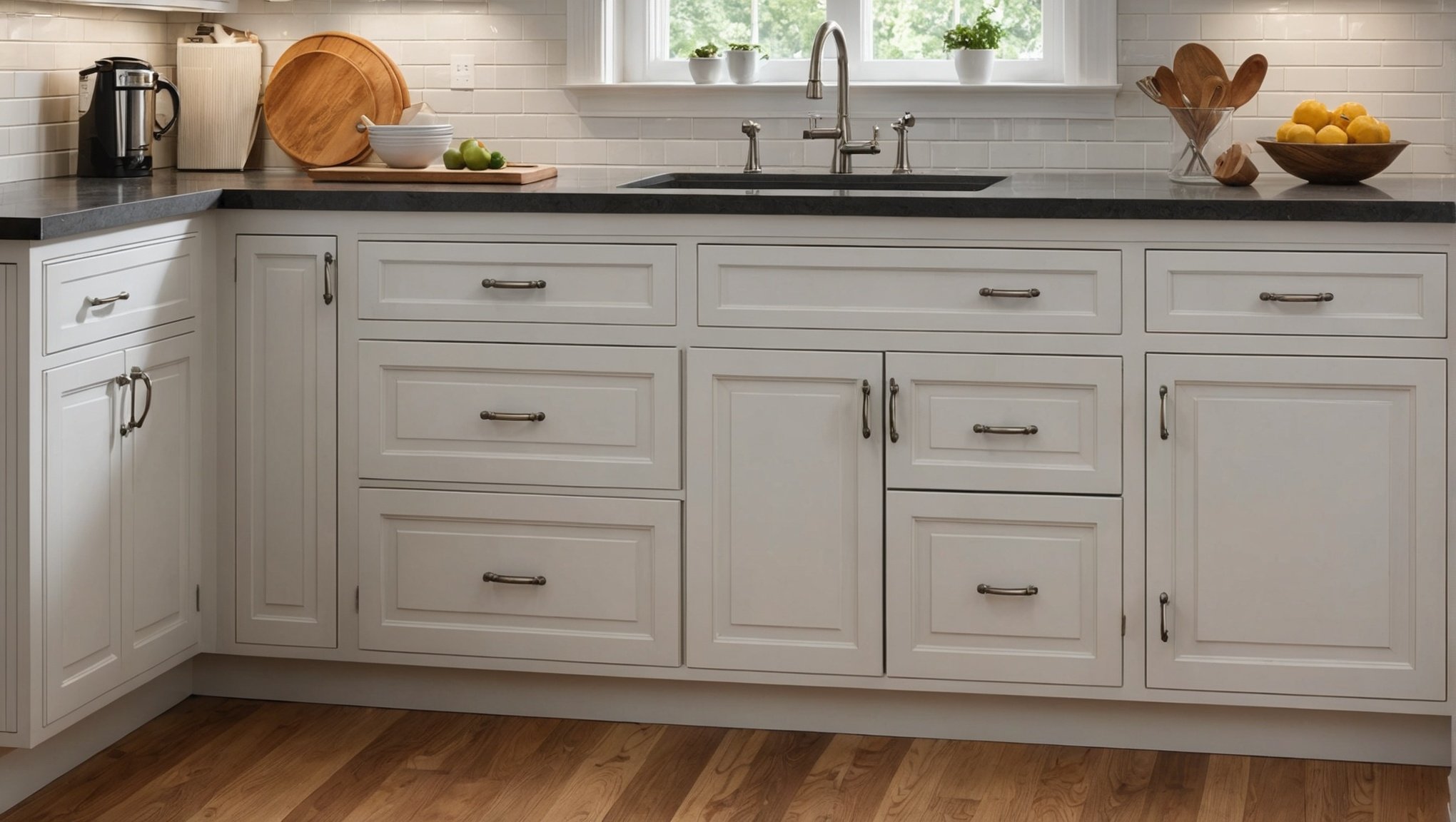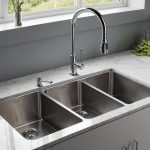Selecting Kitchen Cabinet Handles: A Key Strategy for Preventing Cross-Contamination
When it comes to maintaining a clean and safe commercial kitchen, every detail counts, from the layout of your workspace to the smallest components like cabinet handles. In this article, we will delve into the importance of selecting the right kitchen cabinet handles as a crucial strategy for preventing cross-contamination and ensuring overall kitchen safety.
The Importance of Kitchen Hygiene
Kitchen hygiene is the cornerstone of any successful food establishment. Cross-contamination, which occurs when bacteria or other pathogens are transferred from one food or surface to another, is a significant risk in any kitchen environment. This risk can be mitigated through careful planning and the use of appropriate equipment, including the right cabinet handles.
Also read : Smart Kitchen Designs to Curb Unhealthy Late-Night Snacking Temptations
“Proper waste management and the use of designated areas for trash, recycling, and compost are essential in a commercial kitchen. Similarly, the choice of cabinet handles can play a critical role in maintaining hygiene,” notes an expert from Enviro-Master, emphasizing the comprehensive approach to cleanliness.
Hands-Free Solutions: A Modern Approach to Hygiene
One of the most innovative and effective ways to prevent cross-contamination is by using hands-free cabinet handles. These handles allow staff to open cabinets without touching them, significantly reducing the risk of transferring bacteria.
The Handless Handle, for example, is a discreet and ergonomic solution that can be attached to the base of your cabinets. This product allows staff to use their foot to open the cabinet, eliminating the need to touch potentially contaminated surfaces.
“Using your foot to open the trash can lid or cabinet door reduces the risk of cross-contamination. It’s a small change that makes a big difference in kitchen workflow and hygiene,” explains a user of The Handless Handle, highlighting the convenience and efficiency it brings.
Key Features to Consider in Cabinet Handles
When selecting cabinet handles for your commercial kitchen, several key features should be considered to ensure they contribute to a safe and hygienic environment.
Material and Durability
- Stainless Steel or Antimicrobial Materials: These materials are resistant to bacteria and easy to clean, making them ideal for kitchen environments.
- Durability: Handles should be sturdy and able to withstand frequent use without compromising their functionality.
Ease of Cleaning
- Smooth Surfaces: Handles with smooth surfaces are easier to clean and less likely to harbor bacteria.
- Detachable Parts: Some handles come with detachable parts that can be washed separately, enhancing cleaning efficiency.
Ergonomic Design
- Comfort and Accessibility: Handles should be designed to be comfortable to use, reducing the strain on staff and minimizing the risk of accidents.
- Accessibility: Hands-free options or handles that can be easily operated with minimal force are beneficial for staff who may have mobility issues.
Benefits of Hands-Free Cabinet Handles
Here are some of the key benefits of using hands-free cabinet handles in your commercial kitchen:
- Enhanced Hygiene: Reduces the risk of cross-contamination by minimizing the need for staff to touch potentially contaminated surfaces.
- Convenience: Eliminates the need for staff to bend down or touch dirty lids, streamlining kitchen workflow.
- Effortless Operation: Requires minimal force to activate, making it accessible for all staff members.
- Improved Efficiency: Streamlines kitchen operations by eliminating unnecessary steps and reducing the time spent on opening and closing cabinets.
Practical Tips for Implementing Hands-Free Handles
Implementing hands-free cabinet handles in your commercial kitchen is relatively straightforward but requires some planning. Here are some practical tips:
Measure Your Cabinets
- Ensure the handles fit your cabinets by measuring the base and frame. For products like The Handless Handle, it’s crucial to check if the cabinet is fully flush or almost fully flush.
Clean the Surface
- Before installation, make sure the backside surface of your cabinet is clean. Optionally, wipe it with alcohol to ensure no dirt, dust, or debris are left.
Train Your Staff
- Educate your staff on the proper use of hands-free handles to maximize their benefits. This includes demonstrating how to use the foot lever and emphasizing the importance of hygiene.
Comparison of Different Types of Cabinet Handles
Here is a comparison table highlighting the key features of different types of cabinet handles:
| Type of Handle | Material | Ease of Cleaning | Ergonomic Design | Hands-Free Option | Durability |
|---|---|---|---|---|---|
| Traditional Knob | Various | Moderate | Moderate | No | High |
| Lever Handle | Stainless Steel | High | High | No | High |
| Hands-Free Handle | Antimicrobial | High | High | Yes | High |
| Touchless Sensor | Stainless Steel | Very High | Very High | Yes | Very High |
Employee and Food Safety: Ensuring a Healthy Working Environment
A well-planned kitchen layout and the right cabinet handles are just part of ensuring a healthy working environment. Here are some additional strategies to enhance food safety and hygiene:
Logical Workflow
- Design your kitchen based on the workflow principles: receiving, storage, food preparation, cooking, service, and cleaning. This minimizes cross-traffic and reduces contamination risks.
Safety Equipment
- Ensure your kitchen has necessary safety equipment like fire extinguishers, first aid kits, and eye wash stations. Staff should have easy access to handwashing sinks and personal protective equipment like gloves and aprons.
Regular Safety Training
- Regular safety training for staff is crucial to ensure everyone follows proper food safety protocols. This includes proper hand washing, keeping different types of food separate, and cooking foods to the right temperature.
High-Touch Areas and Cleaning Protocols
In addition to the right cabinet handles, focusing on high-touch areas and implementing robust cleaning protocols is essential.
High-Touch Areas
- Door handles, elevator buttons, restroom fixtures, shared kitchen spaces, and office desks are high-risk areas for germ accumulation. Regular cleaning and disinfection of these areas can prevent cross-contamination.
Professional Cleaning Services
- Investing in professional cleaning services can help target high-touch surfaces and areas that may not always receive thorough cleaning. This includes restroom cleaning, kitchen cleaning, and workstation cleaning.
Selecting the right kitchen cabinet handles is a critical aspect of maintaining a safe and hygienic commercial kitchen. By opting for hands-free solutions, you can significantly reduce the risk of cross-contamination and enhance overall kitchen efficiency.
“By strategically arranging the different areas and workstations in your kitchen, including the choice of cabinet handles, you can address common challenges such as accidents, food wastage, and cross-contamination,” advises an expert from Industry Kitchens, emphasizing the importance of a well-planned kitchen layout.
In conclusion, the right cabinet handles, combined with a well-designed kitchen layout, regular safety training, and robust cleaning protocols, form a comprehensive strategy for preventing cross-contamination and ensuring the health and safety of both your staff and customers.






